Research on High-Precision PGC Demodulation Method for Fabry-Perot Sensors Based on Shifted Sampling Pre-Calibration
Abstract
1. Introduction
2. Measurement Principles
2.1. The Carrier Phase Delay Problem in the PGC Algorithm
2.2. Signal Discretization Model and Phase Offset Mechanism
2.3. Sampling Rate Requirements for Complete Alignment
- (1)
- Mixing: Each sampling point multiplied with carrier (sine/cosine)—2 multiplications
- (2)
- Low-pass filtering: Assuming M-th order FIR filter—2 M multiply-accumulate operations per point (counted as 1 operation each)
- (3)
- Arctangent operation: Using approximation algorithms or lookup tables—about 10 operations per point
2.4. Pre-Alignment and Coefficient Compensation Co-Optimization
3. Experimental Analysis
4. Conclusions
Author Contributions
Funding
Institutional Review Board Statement
Informed Consent Statement
Data Availability Statement
Conflicts of Interest
References
- Ren, Z.J.; Cui, K.; Sun, Y.F. Pipeline anti-vandalism monitoring system based on time division multiplexing interferometric fiber optic sensor array. Opt. Fiber Technol. 2021, 62, 102470. [Google Scholar] [CrossRef]
- Chang, T.Y.; Wang, Z.M.; Yang, Y.; Luo, Z.C.; Wu, C.J.; Cheng, L.Y.; Zheng, Z.F.; Yu, M.; Cui, H.L. A Case Study on Fiber Optic Interferometric Seafloor Seismic and Tsunami Monitoring System in South China Sea. IEEE Trans. Instrum. Meas. 2020, 70, 9501112. [Google Scholar] [CrossRef]
- Ran, Y.L.; Ni, J.L.; Fu, R.Q.; Liu, D.M. Improved PGC demodulation algorithm based on optical fiber laser hydrophone. J. Appl. Opt. 2020, 41, 421–427. [Google Scholar] [CrossRef]
- Sham Kumar, S.; Khansa, C.A.; Praveen, T.V.; Sreehari, C.V.; Santhanakrishnan, T.; Rajesh, R. Assessment of dynamic range in interferometric fiber optic hydrophones based on homodyne PGC interrogator. IEEE Sens. J. 2020, 20, 13418–13425. [Google Scholar] [CrossRef]
- Li, C.X.; Qi, H.C.; Han, X.; Zhao, X.; Zhang, Y.; Huang, J.; Peng, W.; Chen, K. Ultrahigh-speed phase demodulation of a Fabry–Perot sensor based on fiber array parallel spectral detection. Opt. Lett. 2024, 49, 714–717. [Google Scholar] [CrossRef]
- Zhu, Y.; Wang, Z.Y.; Tian, K.; Jing, T.; Guo, X.; Liu, Z. Phase-generated carrier combined with the Hilbert transform for phase demodulation in frequency-scanning interferometry. Opt. Lasers Eng. 2022, 153, 106988. [Google Scholar] [CrossRef]
- Jin, T.; Wang, W.; Daul, L.; Koenders, L.; Hou, W. A low-finesse all-fiber sinusoidal phase modulation interferometer for displacement measurement. Opt. Commun. 2021, 493, 126997. [Google Scholar] [CrossRef]
- Liao, H.; Xie, J.; Yan, L.; Chen, B.; Lou, Y.; Chen, H.; Guo, G. Precision vibration measurement using differential phase-modulated homodyne interferometry. Opt. Lasers Eng. 2023, 169, 107695. [Google Scholar] [CrossRef]
- Fang, G.; Xu, T.; Feng, S.; Li, F. Phase-sensitive optical time domain reflectometer based on phase-generated carrier algorithm. J. Light. Technol. 2015, 33, 2811–2816. [Google Scholar] [CrossRef]
- Chai, Q.; Luo, Y.; Ren, J.; Zhang, J.; Yang, J.; Yuan, L.; Peng, G. Review on fiber-optic sensing in health monitoring of power grids. Opt. Eng. 2019, 58, 072007. [Google Scholar] [CrossRef]
- Zhang, S.; Zhang, X.; Jiang, J.; Liu, K.; Wang, R.; Sun, J.; Zhang, S.; Liu, T. Partial discharge monitoring by improved PGC-arctan algorithm. Opt. Commun. 2024, 570, 130879. [Google Scholar] [CrossRef]
- Yu, Z.; Dai, H.; Zhang, M.; Zhang, J.; Liu, L.; Jin, X.; Luo, Y. High stability and low harmonic distortion PGC demodulation technique for interferometric optical fiber sensors. Opt. Laser Technol. 2019, 109, 8–13. [Google Scholar] [CrossRef]
- Li, Y.; Wang, Y.; Xiao, L.; Bai, Q.; Liu, X.; Gao, Y.; Zhang, H.; Jin, B. Phase Demodulation Methods for Optical Fiber Vibration Sensing System: A Review. IEEE Sens. J. 2022, 22, 1842–1866. [Google Scholar] [CrossRef]
- Huang, S.C.; Lin, H. Modified phase-generated carrier demodulation compensated for the propagation delay of the fiber. Appl. Opt. 2007, 46, 7594–7603. [Google Scholar] [CrossRef]
- Zhang, S.; Yan, L.; Chen, B.; Xu, Z.; Xie, J. Real-time phase delay compensation of PGC demodulation in sinusoidal phase-modulation interferometer for nanometer displacement measurement. Opt. Express 2017, 25, 472–485. [Google Scholar] [CrossRef]
- Volkov, A.V.; Plotnikov, M.Y. Phase modulation depth evaluation and correction technique for the PGC demodulation scheme in fiber-optic interferometric sensors. IEEE Sens. J. 2017, 17, 4143–4150. [Google Scholar] [CrossRef]
- Xie, J.; Yan, L.; Chen, B.; Lou, Y. Extraction of carrier phase delay for nonlinear errors compensation of PGC demodulation in an SPM interferometer. J. Light. Technol. 2019, 37, 3422–3430. [Google Scholar] [CrossRef]
- Li, S.; Shao, S.; Mei, H.; Hao, Q.; Rao, R. Analysis and mitigation of the carrier phase delay effect of the digital phase generated carrier algorithm. Appl. Opt. 2017, 56, 731–738. [Google Scholar] [CrossRef] [PubMed]
- Qu, Z.; Guo, S.; Hou, C.; Yang, J.; Yuan, L. Real-time self-calibration PGC-Arctan demodulation algorithm in fiber-optic interferometric sensors. Opt. Express 2019, 27, 23593. [Google Scholar] [CrossRef] [PubMed]
- Qian, X.; Kong, Y.; Du, T.; Wang, Z.; Ding, W. Modified phase-generated carrier demodulation compensated for the propagation delay of the fiber. Opt. Commun. 2020, 457, 124595. [Google Scholar] [CrossRef]
- Nikitenko, A.N.; Plotnikov, M.Y.; Volkov, A.V.; Mekhrengin, M.V.; Kireenkov, A.Y. PGC-Atan demodulation scheme with the carrier phase delay compensation for fiber-optic interferometric sensors. IEEE Sens. J. 2018, 18, 1985–1992. [Google Scholar] [CrossRef]
- Peng, F.; Hou, L.; Yang, J.; Yuan, Y.; Li, C.; Yan, D.; Yuan, L.; Zheng, H.; Chang, Z.; Ma, K.; et al. An improved fixed phased demodulation method combined with phase generated carrier (PGC) and ellipse fitting algorithm. Proc. SPIE 2015, 9620, 96200S. [Google Scholar]
- Ni, C.; Zhang, M.; Zhu, Y.; Hu, C.X.; Ding, S.Q.; Jia, Z. Sinusoidal phase-modulating interferometer with ellipse fitting and a correction method. Appl. Opt. 2017, 56, 3895–3899. [Google Scholar] [CrossRef]
- Yan, L.; Chen, Z.; Chen, B.; Xie, J.; Zhang, S.; Lou, Y.; Zhang, E. Precision PGC demodulation for homodyne interferometer modulated with a combined sinusoidal and triangular signal. Opt. Express 2018, 26, 4818–4831. [Google Scholar] [CrossRef] [PubMed]
- Ma, T.; Zhao, L.; Gao, H.; Fu, Z.; Qiao, X. An improved PGC demodulation algorithm for optical fiber interferometers with insensitive to carrier phase delay and modulation depth. Opt. Fiber Technol. 2022, 74, 103121. [Google Scholar] [CrossRef]
- Dong, Y.; Hu, P.; Ran, M.; Fu, H.; Yang, H.; Yang, R. Correction of nonlinear errors from PGC carrier phase delay and AOIM in fiber-optic interferometers for nanoscale displacement measurement. Opt. Express 2020, 28, 2611–2624. [Google Scholar] [CrossRef]
- Yan, L.; Zhang, Y.; Xie, J.; Lou, Y.; Chen, B.; Zhang, S.; Zhou, Y. Nonlinear error compensation of PGC demodulation with the calculation of carrier phase delay and phase modulation depth. J. Light. Technol. 2021, 39, 2327–2335. [Google Scholar] [CrossRef]

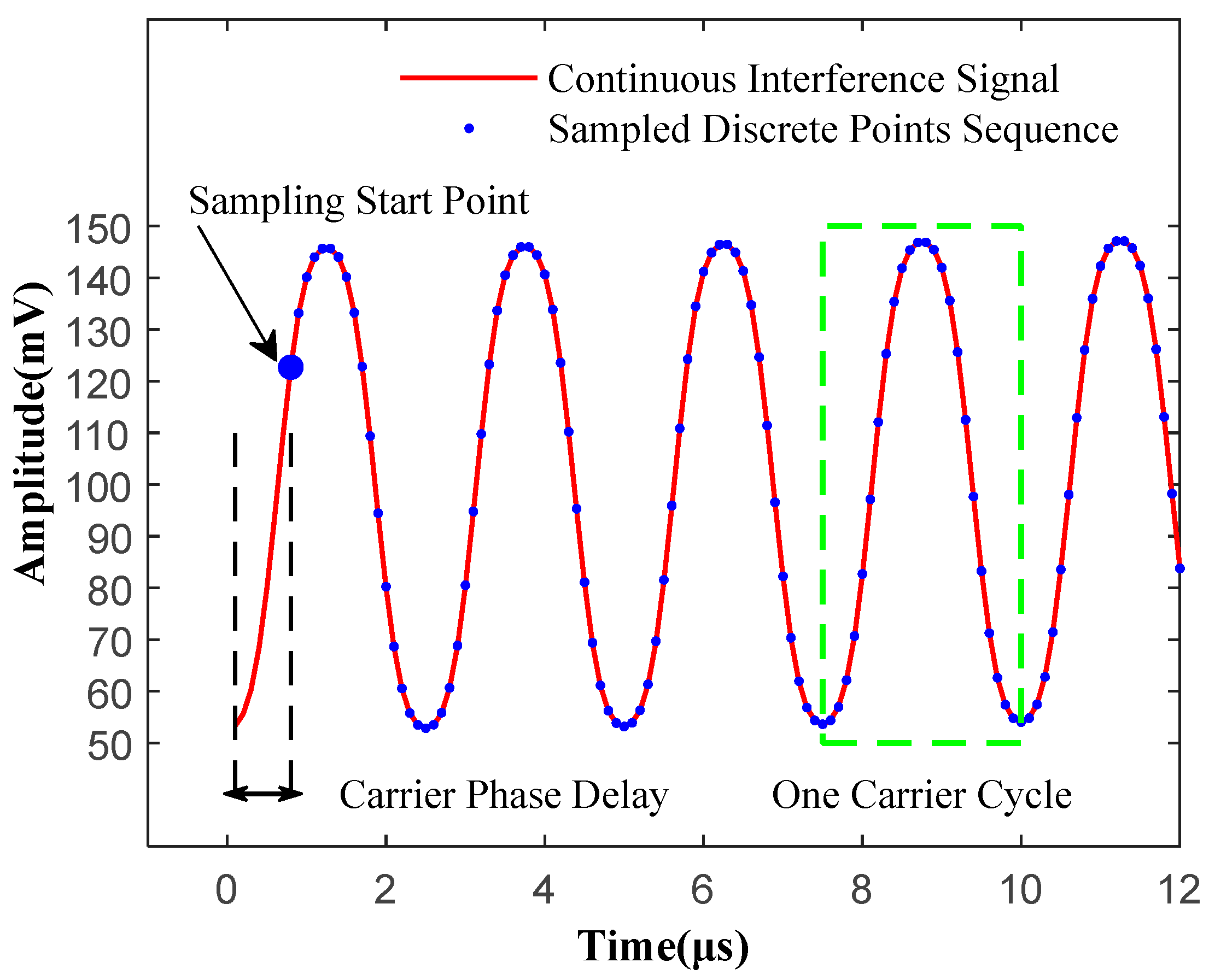
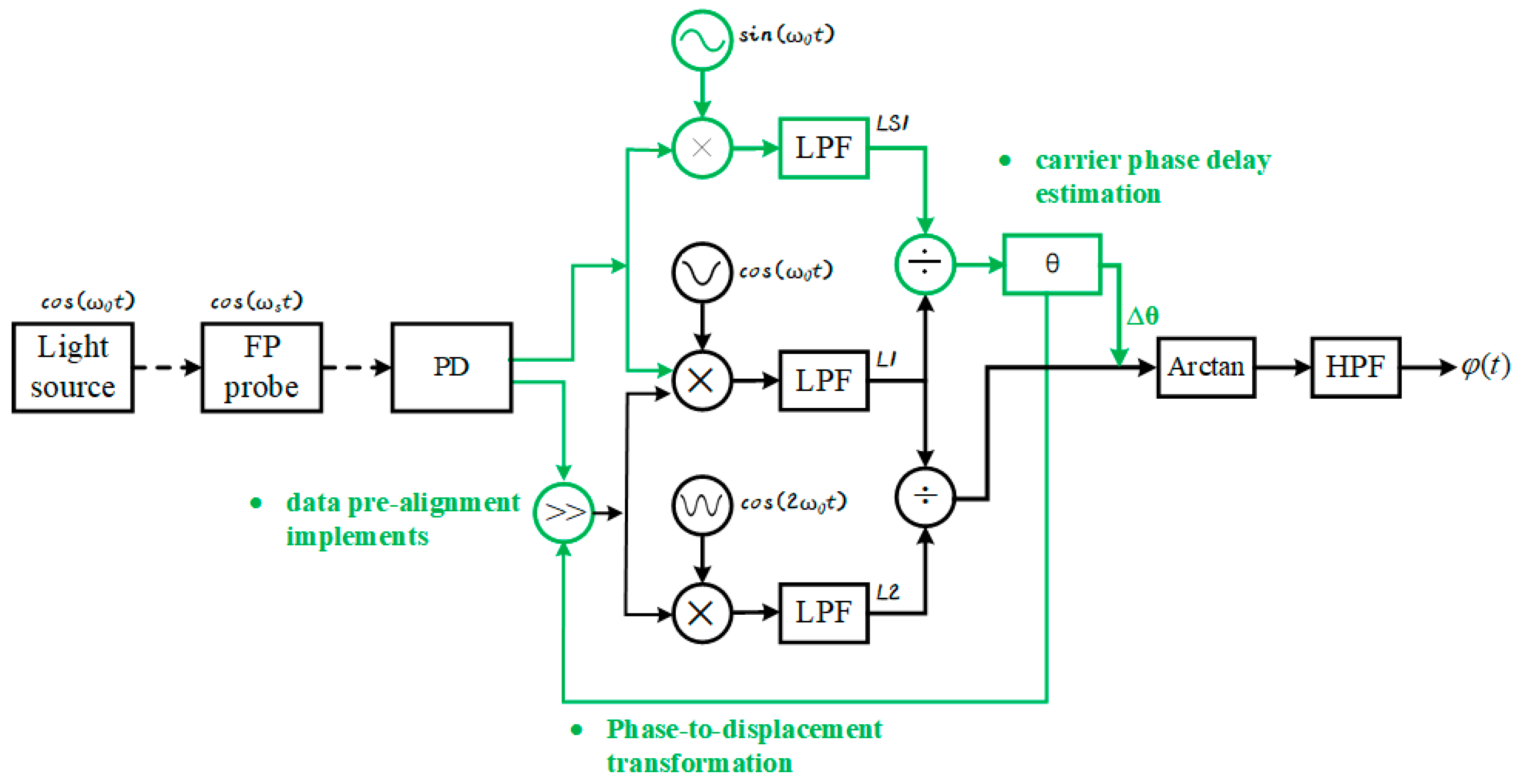
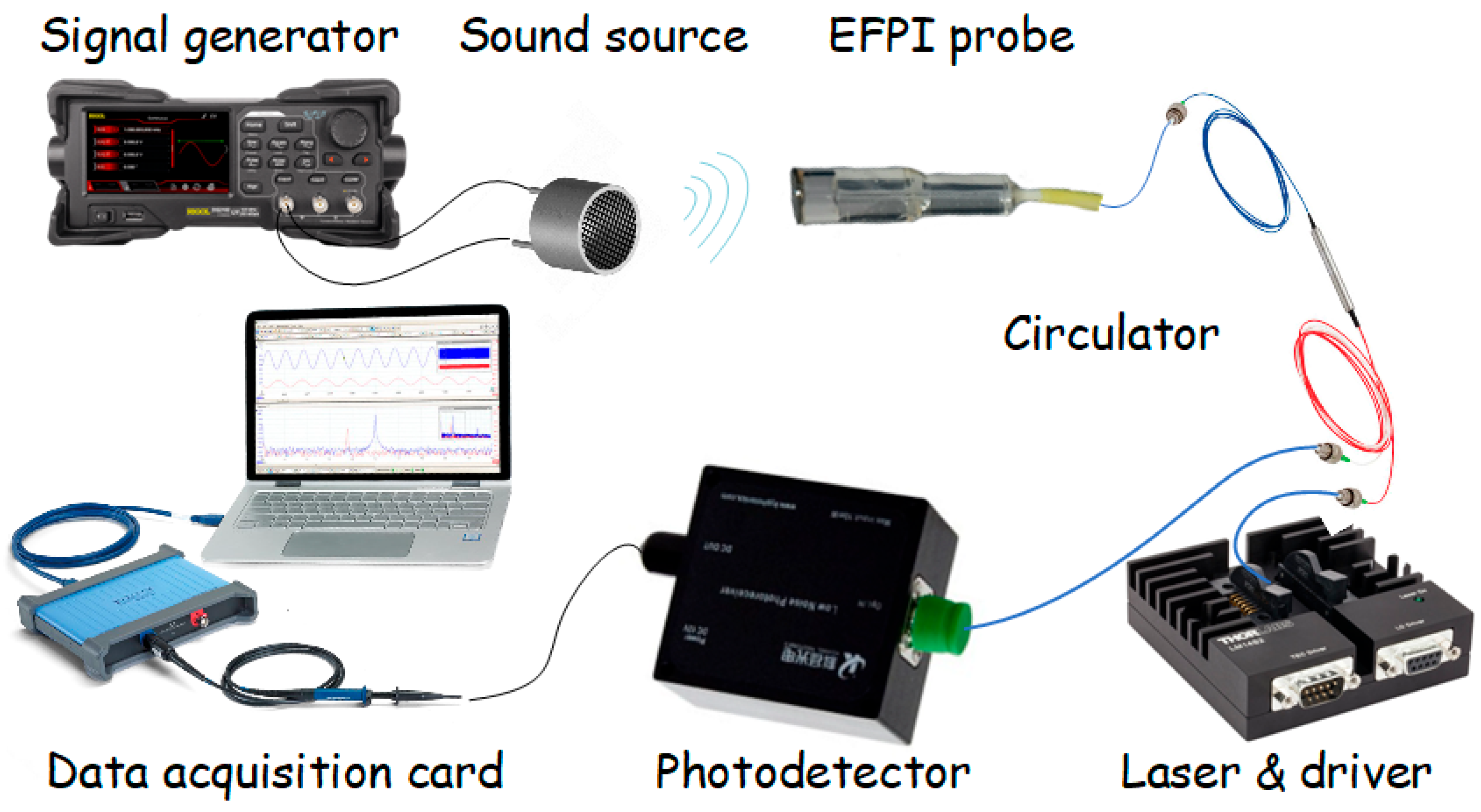


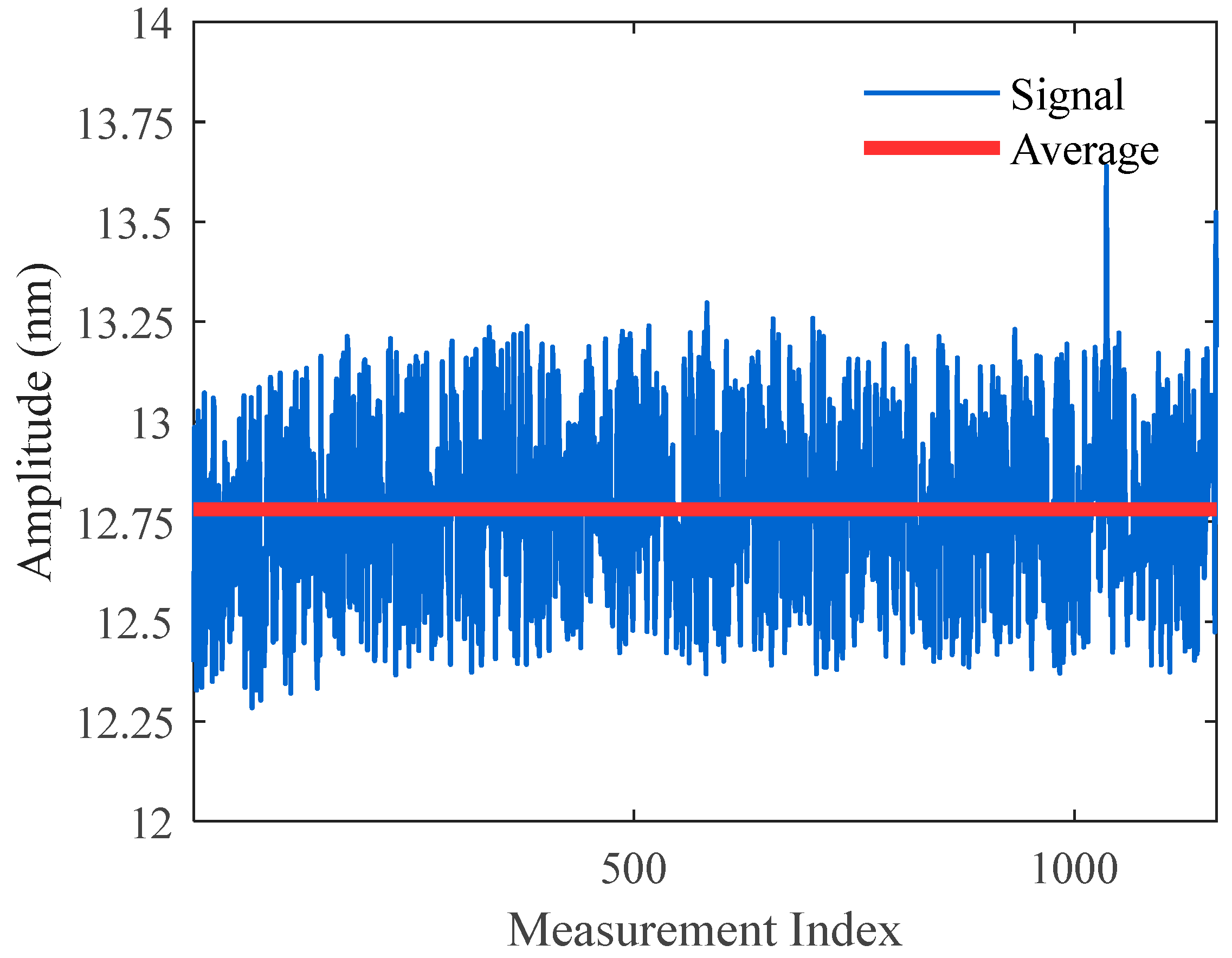
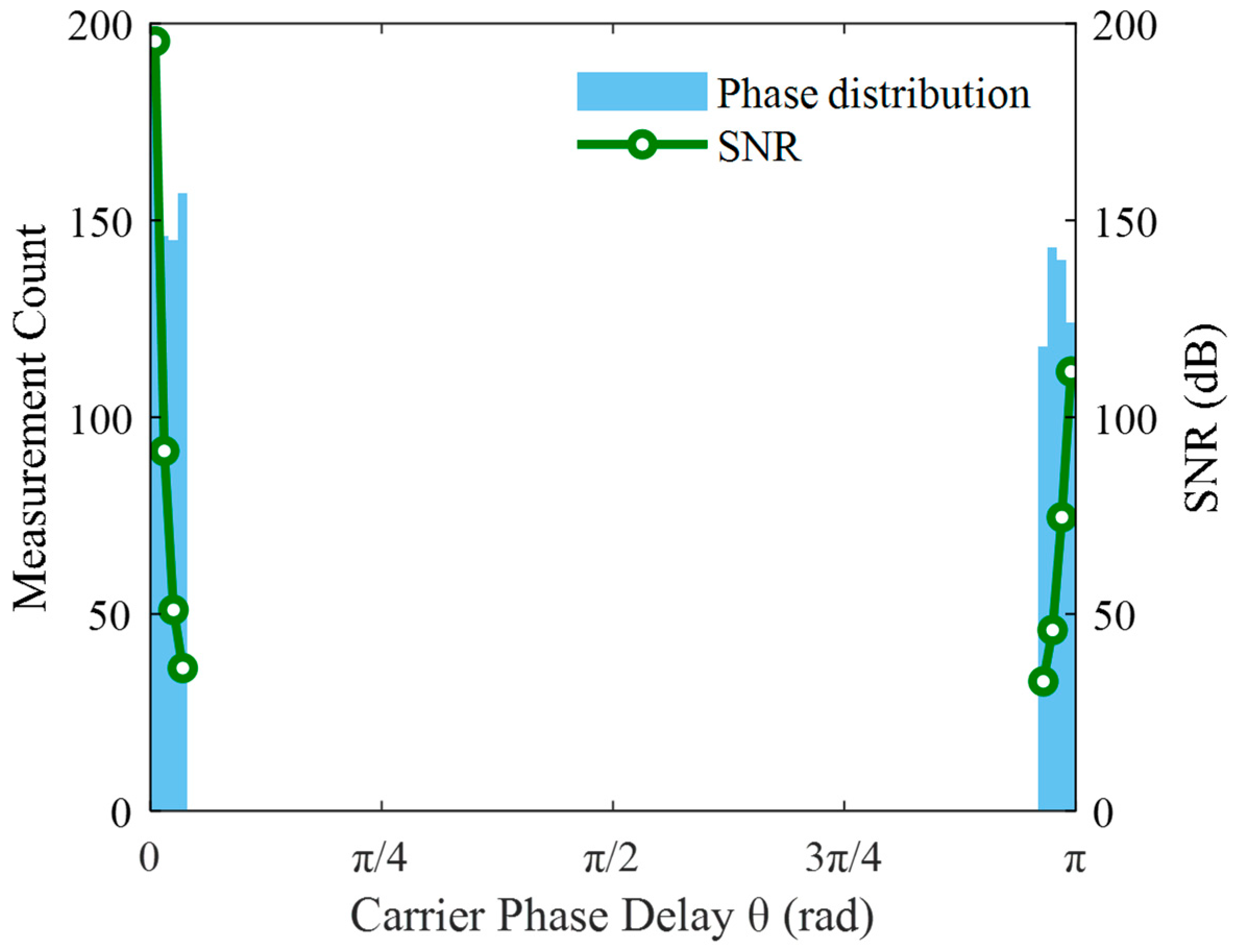
Disclaimer/Publisher’s Note: The statements, opinions and data contained in all publications are solely those of the individual author(s) and contributor(s) and not of MDPI and/or the editor(s). MDPI and/or the editor(s) disclaim responsibility for any injury to people or property resulting from any ideas, methods, instructions or products referred to in the content. |
© 2025 by the authors. Licensee MDPI, Basel, Switzerland. This article is an open access article distributed under the terms and conditions of the Creative Commons Attribution (CC BY) license (https://creativecommons.org/licenses/by/4.0/).
Share and Cite
Li, Q.; Shao, J.; Wu, P.; Liang, J.; Lu, Y.; Zhang, M.; Qiu, Z. Research on High-Precision PGC Demodulation Method for Fabry-Perot Sensors Based on Shifted Sampling Pre-Calibration. Sensors 2025, 25, 5990. https://doi.org/10.3390/s25195990
Li Q, Shao J, Wu P, Liang J, Lu Y, Zhang M, Qiu Z. Research on High-Precision PGC Demodulation Method for Fabry-Perot Sensors Based on Shifted Sampling Pre-Calibration. Sensors. 2025; 25(19):5990. https://doi.org/10.3390/s25195990
Chicago/Turabian StyleLi, Qun, Jian Shao, Peng Wu, Jiabi Liang, Yuncai Lu, Meng Zhang, and Zongjia Qiu. 2025. "Research on High-Precision PGC Demodulation Method for Fabry-Perot Sensors Based on Shifted Sampling Pre-Calibration" Sensors 25, no. 19: 5990. https://doi.org/10.3390/s25195990
APA StyleLi, Q., Shao, J., Wu, P., Liang, J., Lu, Y., Zhang, M., & Qiu, Z. (2025). Research on High-Precision PGC Demodulation Method for Fabry-Perot Sensors Based on Shifted Sampling Pre-Calibration. Sensors, 25(19), 5990. https://doi.org/10.3390/s25195990






